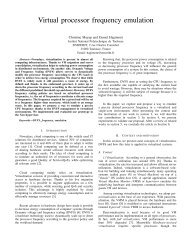SESSION NOVEL ALGORIHMS AND APPLICATIONS + ...
SESSION NOVEL ALGORIHMS AND APPLICATIONS + ...
SESSION NOVEL ALGORIHMS AND APPLICATIONS + ...
Create successful ePaper yourself
Turn your PDF publications into a flip-book with our unique Google optimized e-Paper software.
40 Int'l Conf. Foundations of Computer Science | FCS'11 |<br />
Now, the convex hull of the presumptive line's lower half is<br />
computed and the presumptive line is deleted. All remaining<br />
vertices would be sorted from left to right in the order of<br />
and the most left and the most right points would be joined to<br />
the left and right end vertices of convex hull, respectively.<br />
Then, like the above algorithm, vertices and have<br />
been considered as it's explain before in the previous<br />
algorithm (Fig 3-a) and the edges is replaced<br />
with the edges ( (Fig 3-b). the created polygon is<br />
a simple random polygon.<br />
(a)<br />
(b)<br />
Fig. 3. (a) Creating a polygon with the Convex Buttom<br />
algorithm, (b) creating the random polygon by replacing the<br />
of edges with the edges .<br />
The procedure of this algorithm with assumption the existing<br />
convex bottom algorithm is as the following:<br />
• First, would be computed over the set of<br />
random vertices .<br />
• The set of interior vertices is considered as<br />
and the vertex with the least -coordinate is selected<br />
from the set of vertices (vertex ).<br />
• The Convex Bottom algorithm is called for those<br />
vertexes which are inside of the convex hull (the set<br />
).<br />
• The closest vertex to vertex is selected From the<br />
set of vertices over (vertex ).<br />
• The vertex close to and the vertex close to in the<br />
counter-clockwise is called and , respectively.<br />
• The edges is replaced with the edges<br />
.<br />
3.3 Algorithm 3<br />
In this algorithm like the two previous algorithms, first<br />
is computed. Let be the vertex set inside of the<br />
convex hull . for this set of vertices, the existing<br />
TwoPeasants algorithm (for the presumptive line according to<br />
-coordinate) would be applied which it has time complexity<br />
and performs in this way that first two vertices<br />
which has the least and the most -coordinate is considered.<br />
These vertices would be joined together using a presumptive<br />
line so that the set of vertices would be divided into two<br />
upper and lower half (if the set of vertices is empty, the<br />
algorithm executes again) [7]. The next steps are as the<br />
following: The upper half vertices would be sorted while they<br />
started from the left end point and the lower vertices would be<br />
sorted like this way and the end vertices would be joined from<br />
both sides and like two previous algorithms the vertices<br />
and as it's explained before in section 3-2 have been<br />
considered (Fig 4-a) and the edges is replaced<br />
with the edges . The shape which is obtained is a<br />
simple random polygon (Fig 4-b). Thus the created polygon<br />
in this way is a simple random polygon. The procedure of this<br />
algorithm with assumption the existing TwoPeasants<br />
algorithm is as the following:<br />
• First, would be computed over the set of<br />
random vertices .<br />
• The set of interior vertices is considered as<br />
and the vertex with the least -coordinate is selected<br />
from the set of vertices (vertex ).<br />
• The TwoPeasants algorithm is called for those<br />
vertexes which are inside of the convex hull (the set<br />
).<br />
• The closest vertex to vertex is selected From the<br />
set of vertices over (vertex ).<br />
• From the set of vertices over , the closest<br />
vertex to vertex is selected ( vertex ).<br />
• The vertex close to and the vertex close to in the<br />
counter clockwise is called and respectively.<br />
• The edges is replaced with the edges<br />
.









